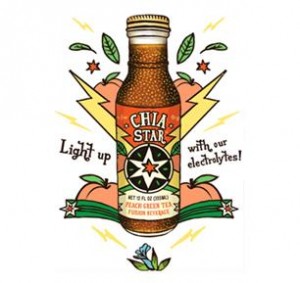
“If you’re in food, you know what it is,” Davis said. “Is the penetration 100 percent across the board if I asked everyone about chia seeds? No, probably all of them have heard of a chia pet. But I’d say the awareness is definitely growing.”
The chia category has passed a few natural-channel introductory stages: the Dr. Oz approval, the first-to-market brands (Mamma Chia and Chia\Vie), the blog rounds. However, a second layer of chia beverage companies, notably Drink Chia and Chia Star, which recently displayed their beverages, stories and plans at the Natural Products Expo East show in Baltimore, are emerging and increasing distribution. Whether or not they sustain momentum could depend on the mainstream viability of chia beverage products. As of now, it seems to be a waiting game.
“I don’t think it’s such a stretch for people to think about drinking it,” Davis said. “I think from a mass standpoint, people either like texture in a drink or they don’t. So whether it hits a coconut water growth, yet to be seen.”
Mamma Chia has been featured in The New York Times and The Wall Street Journal, reached nationwide availability one year after its launch and continues to grow. Chia\Vie, which uses ground chia seeds instead of the more common whole seeds, has established itself as the second brand to test the category. L.A. Libations, a beverage incubation firm, announced an investment in Chia\Vie at Natural Products Expo West in March. The beverage has already landed distribution in Costco, Target, Kroger and HEB stores.
So with the head start that those products have, are new category entrants even relevant?
Vitamin Shoppe seems to think so. At the beginning of September, Drink Chia announced that it has entered all 622 Vitamin Shoppe stores locations across the U.S., Puerto Rico and Ontario. The increased distribution will give Davis and the rest of the beverage industry a way to get a better read on the category’s potential.
“There’s a lot of acceptance toward anything with chia in it,” Davis said. “We’re trying to get a pulse.”
Davis said that while Mamma Chia has done a nice job in the category, she believes that Drink Chia works best for consumers with a busy, active lifestyle. While Mamma Chia comes in 10 oz. glass bottles and 3.5 oz. squeezable pouches, Drink Chia comes in 10 oz., BPA-free plastic bottles. Davis said that this packaging form makes it more portable and shelf-stable. She also mentioned that it’s a lighter beverage with a more chuggable consistency, which could be made even lighter for more mainstream consumers.
“We just felt it was maybe a little bit more of an approachable chia drink product on the market,” she said.

“I did not know what I was getting into in the beverage world,” she said. “I didn’t. This is super-competitive.”
Erb worked as a holistic nutritionist for 25 years, operating one of the first full-service natural food stores in New Jersey: Mrs. Erb’s Good Food. She sold the store 10 years ago and it’s still running today, but under the name “Grassroots.”
She originally just wanted to share the dense, omega-rich qualities of chia at soup kitchens until she discovered chia beverages. Now, she wants to sell her drink, Chia Star, to raise money for FoodCorps, an organization that helps build school gardens and educate kids about nutrition, and to eventually bring chia and other food innovations back to soup kitchens and schools.
Chia Star has been on the market for about one year and three months, and Erb said that she hasn’t yet reached profitability. She once thought that getting into Whole Foods was one of the greatest challenges. She then quickly learned about her continuing role in the development of Chia Star’s presence, such as samplings and demonstrations.
“If you aren’t there, working every one of the stores in whatever region you’re in, boy, you could get dropped off that shelf in a heartbeat,” she said.
Erb said that she has no idea when her product will be profitable, however she does feel assured to work in a category that has fellow brands she views more as support than competition. She said because
the category is so new, the other brands simply increase awareness, curiosity and credibility.
“If we can’t make a sector, people will walk right by you,” she said.
The category’s future now hinges on what people do once they stop.